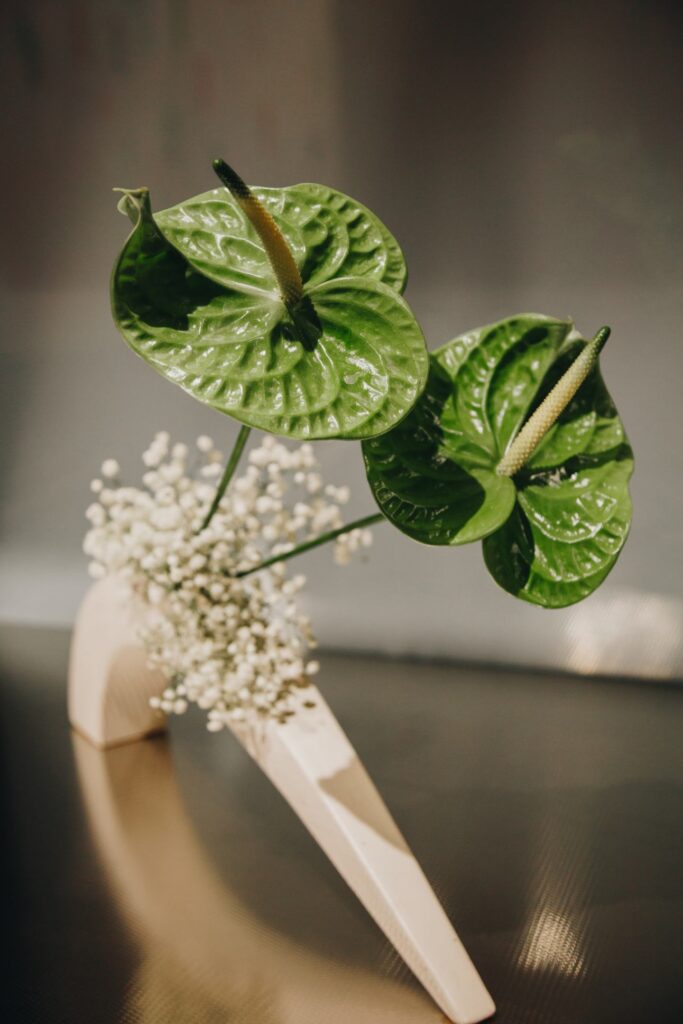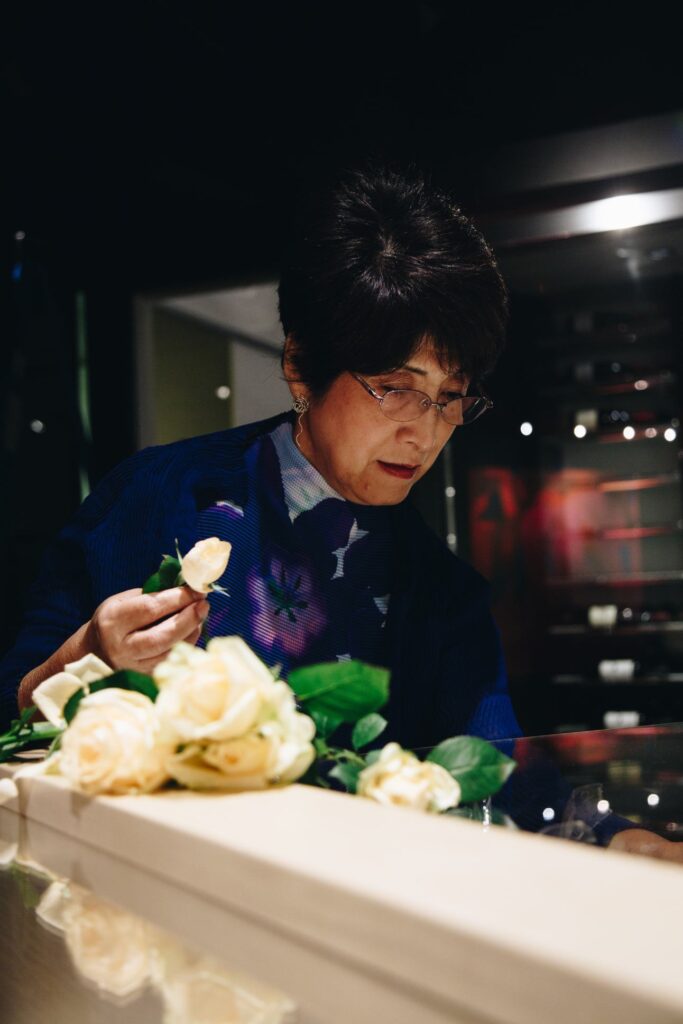Text by Natalie Schack
Images by Skye Yonamine
There’s something unusual on display at Studio Becker. The interior of the showroom of high-end closet and cabinet installations is brightly lit as usual, revealing luxurious textures and gleaming marble. Tonight, however, there’s an added element—or rather, a duality of elements. The first is an array of botanicals, including gently arching branches, bursts of blossoms, undulating fronds, and swirling leaves. It’s an explosion of nature. This nature is set, unexpectedly, alongside the second element: recycled this-and-that including garden tubing, plastic netting, and cardboard egg boxes. The flotsam and jetsam of modern life act as dance partners for the graceful waltz of the floral arrangements.
This is the latest installation from ikebana artist Carole Sakata and her team of students, who create pieces for Studio Becker each year. For this presentation, Sakata decided to do something a little different and incorporate manmade components. The result is an ikebana exhibit that is a far cry from the typical pieces found in high-end hotels or shopping centers.
Sakata hails from the sogetsu school of ikebana, which cherishes such unconventionality. Unlike the staunchly traditional ikenobo, or the garden aesthetics of ohara, sogetsu stands out for its mold-breaking freedom and its departure from pre-established forms. Sogetsu founder Sofu Teshigahara was born in 1900 under a father who was a follower of old-school ikebana. “Teshigahara always wanted to do something different. And the father would tell him, ‘No, you can’t,’” Sakata says. “But I think, looking at art, he said: You can do with the paint whatever you want to do with the paint. I’m sure you can do with the flower anything you want to do.”

In the past, sogetsu artists have used whatever was medium was available, whatever medium made sense. With World War II and the ensuing exchange of cultures, the school gained heightened interest. The looseness and freedom for creative expression appealed to foreigners.
It also appealed to Sakata. She traces her interest in the art to the early 1980s, when she moved back to Japan with her husband for his work. She had been born in Japan but had relocated to Hawai‘i at age 13. Back in the country of her birth as a mother of two school-age boys, she needed something to throw herself into.
Today, she walks through the showroom explaining work by her and her master students. She points out the strength of one fixture—“I like to get a very strong feeling,” she says, “not putting lots of things to make it strong, but that one line that has that strength”—and the forwardness of another. In one arrangement, she explains how the artist achieved the feeling of floating, of a flower hovering in its place, defying the rules of physics. In another, she highlights the essential role played by absence, how the popcorn orchids and the emptiness around them create an interplay of form and negative space.


It has been 34 years since Sakata started studying that balance through the art of ikebana. Today, she is a renowned and respected teacher and practitioner of ikebana in Hawai‘i. Most of her 50 students have been with her for more than a decade, and some of them for two decades. They’re a community now, friends who get together every week to create beauty out of the popcorn orchid, mock orange, or tropical ferns that Sakata amasses from her yard, her neighbors’ yards, and Watanabe Floral.
“Ikebana is a way of life. It’s not something that you start and you finish,” she says. “You will practice once every day, or once every week, or whatever, and it’s with you all your life. That’s how the Japanese look at art.”

I cannot explain to you what is space in ikebana. But as you learn, that will develop with you.
Carole Sakata, ikebana artist
How to Enhance an Ikebana Arrangement
Here are a few vital elements to consider in order to successfully incorporate ikebana into any living space.
By Carole Sakata
Placement:
Ikebana arrangement can be arranged and placed anywhere but it will look better against a wall, especially by the entrance to your home.
Volume:
Unlike Western flower arrangement, ikebana uses less plant materials emphasizing every flower and branch. Negative space in an Ikebana arrangement is very important.
Vases:
Ikebana can be arranged in various vases such as a flat vase with a frog (kenzan) or in a tall vase. When arranging in a flat vase, be sure to feature water as one of the main elements in the arrangement. With a tall vase, materials used should not cover the entire mouth (top) of the container. Use half of its mouth to one side, then the arrangement will look light and airy.
Color:
In any art, coordinating colors is important. Using color in contrast or associated color (same tone) will enhance an ikebana arrangement. Ikebana is art, so treat it as art, not as decoration.





